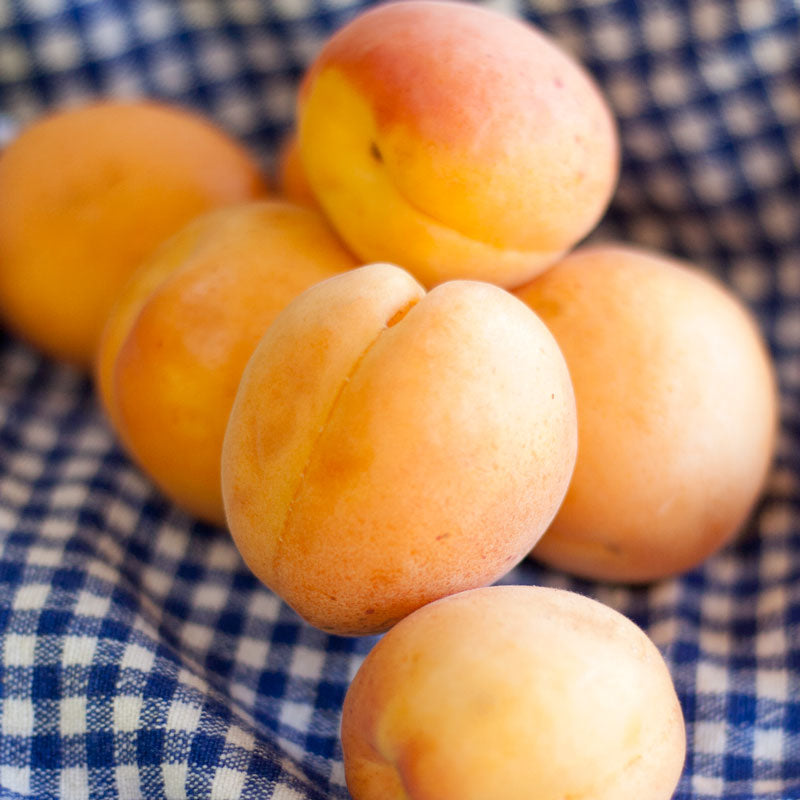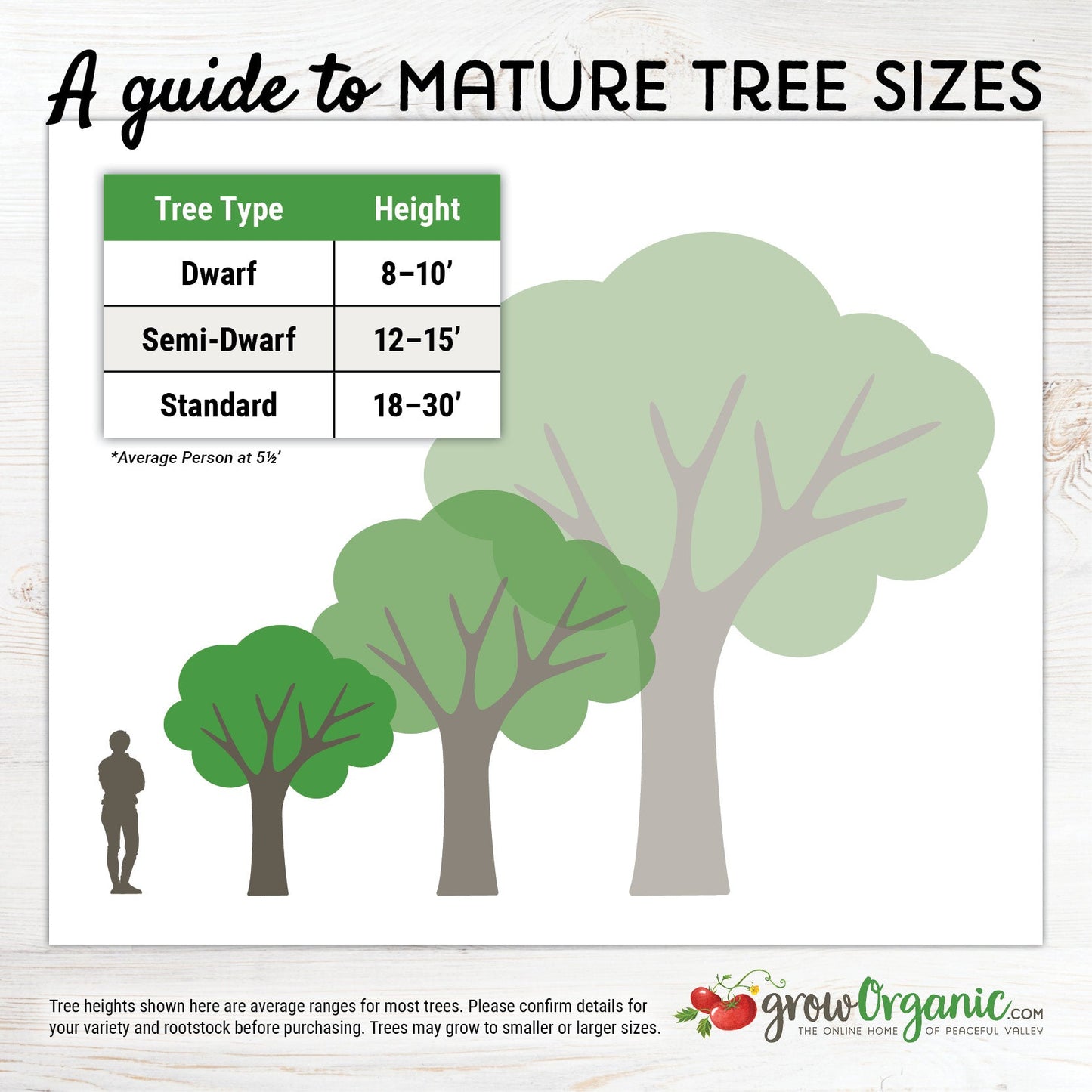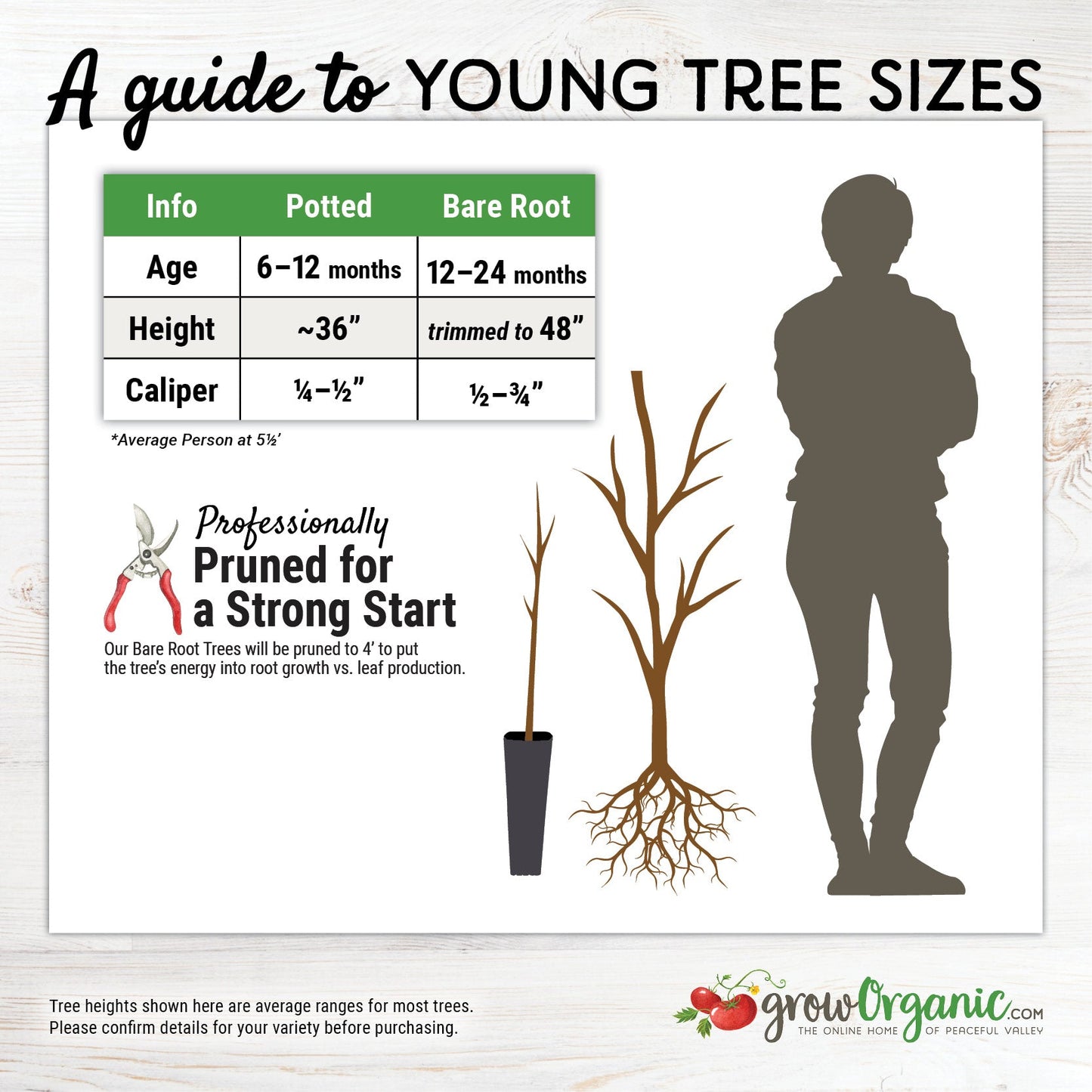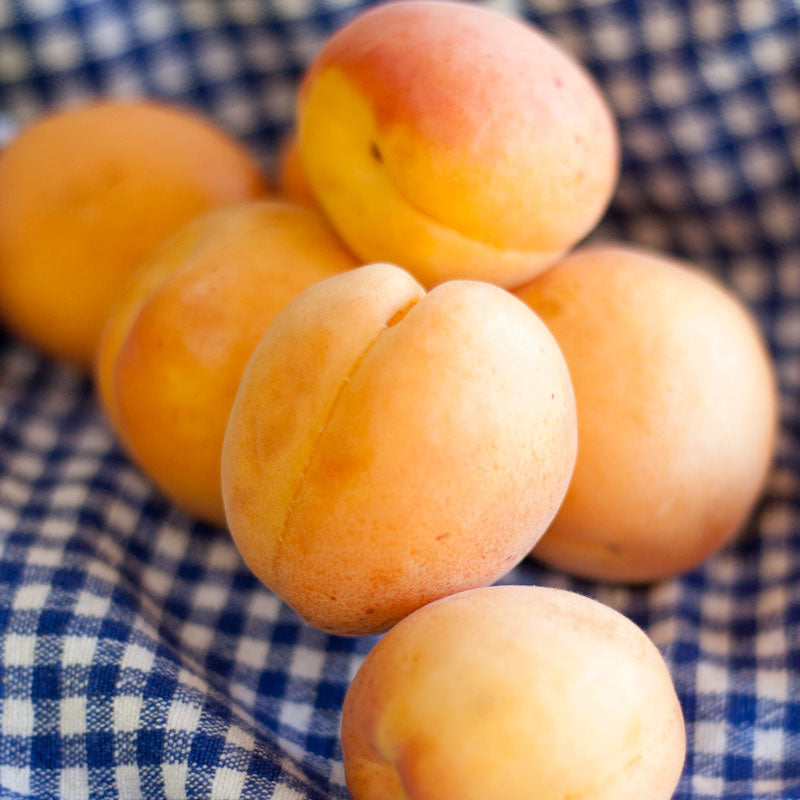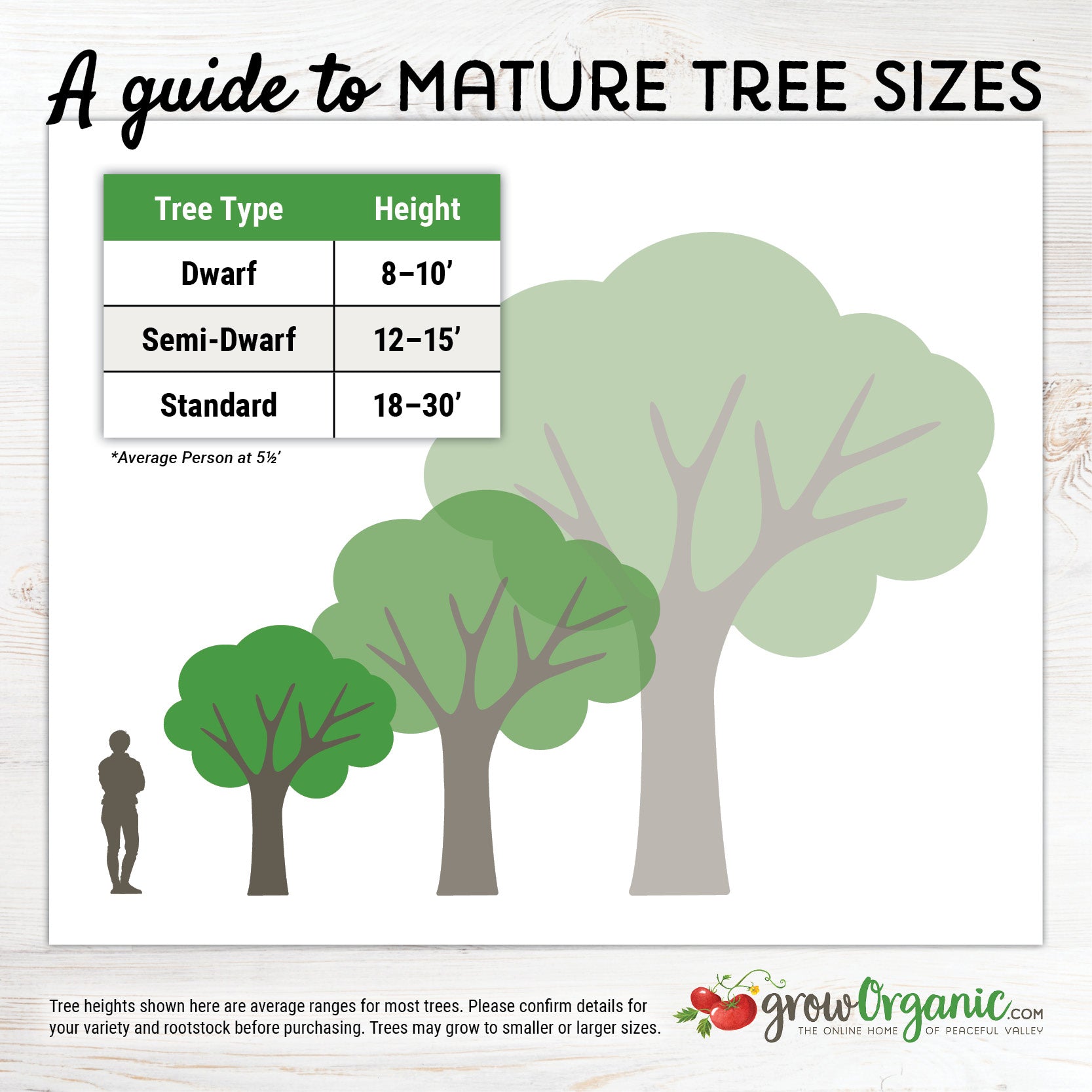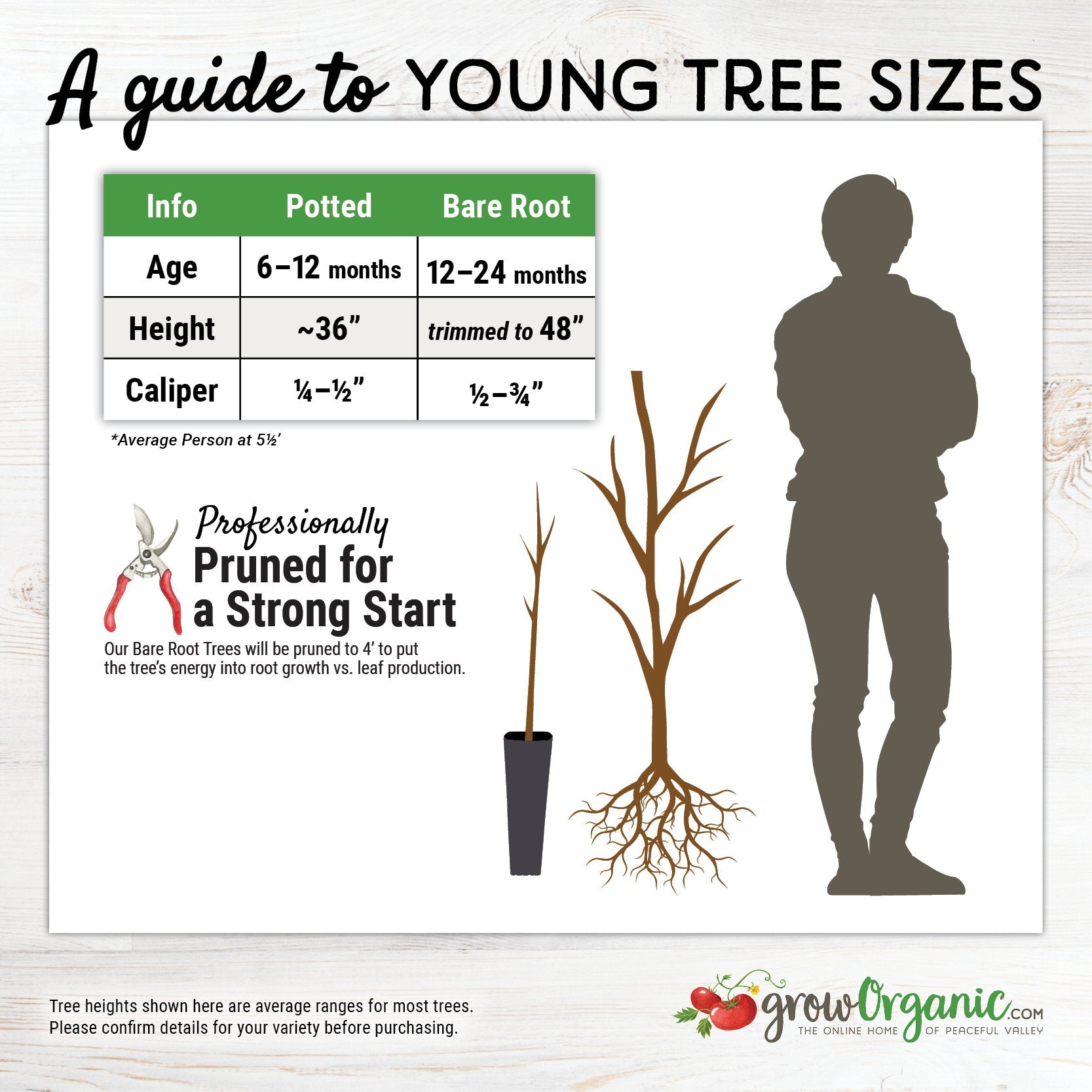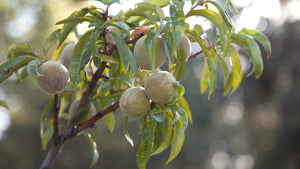Item Number: FT065P
Royal Blenheim Apricot Tree
Royal Blenheim Apricot Tree
Good All Purpose Apricot
Semi-dwarf on Citation rootstock.
- Zones: 5-9
- Chill hours: 400-500
- Bloom Time: Early (Based on typical Central Valley California weather)
- Harvest: June 25 - July 5
- Looks: Freestone. Classic apricot.
- Personality: Sweet, aromatic, and flavorful.
- Facts of note: This variety has migrated from such royal grounds as the birthplace of Sir Winston Churchill to become one of California's favorite apricots. Blenheim is considered to be the most flavorful, best tasting apricot in production. The fruit is medium to large, yellow with orange cheek and firm, juicy, pale orange flesh and delicious flavor. Enjoy the fruit for fresh eating, cooking, canning, drying, freezing, juice and jams and jellies. Blenheim apricot trees explode with fragrant white blossoms in early Spring. The top height of 18 to 20 feet and its beautiful mushroom shape make it a very attractive tree in the landscape. The trees can live for up to 75 years.
- Pollination: Self-fruitful.
The Royal Blenheim Apricot tree (Prunus armeniaca 'Royal Blenheim') is a semi-dwarf fruit tree that has gained popularity among gardeners and orchard enthusiasts for its delicious, sweet-tasting apricots and manageable size. In this article, we will delve into the characteristics, care, and benefits of the Royal Blenheim Apricot tree, which can be found on GrowOrganic.com.
Overview of the Royal Blenheim Apricot Tree
The Royal Blenheim Apricot tree is a semi-dwarf variety, making it an excellent choice for smaller gardens or those looking to conserve space in their orchard. This apricot tree typically reaches a mature height of around 12 to 15 feet, with a similar spread, making it manageable for pruning, harvesting, and maintenance.
Fruit Characteristics
One of the key attractions of the Royal Blenheim Apricot tree is its delicious fruit. The apricots produced by this tree are renowned for their exceptional flavor and sweetness. These apricots are medium-sized and have a beautiful golden-yellow skin with a slight blush of red when fully ripe. The fruit's flesh is juicy and tender, offering a delectable balance of sweetness and tartness that makes them perfect for eating fresh, canning, drying, or making jams and preserves.
Blossom and Pollination
The Royal Blenheim Apricot tree produces lovely pinkish-white blossoms in early spring, creating a picturesque sight in your garden. It is essential to note that apricots, including the Royal Blenheim, are self-pollinating, which means they do not require another apricot tree for cross-pollination. However, having multiple apricot trees can increase fruit production and yield.
Planting and Care
To ensure the healthy growth of your Royal Blenheim Apricot tree and a bountiful harvest, here are some essential care guidelines:
Location: Choose a sunny spot in your garden with well-drained soil. Apricots thrive in full sunlight, which is crucial for fruit development.
Planting: Plant the tree in a hole that is twice as wide as the root ball and at the same depth. Water thoroughly after planting, and mulch the base to conserve moisture and deter weeds.
Pruning: Regular pruning helps maintain the tree's shape, removes dead or diseased branches, and encourages fruit production. Prune during the dormant season to avoid interfering with blossoms or fruit.
Watering: Adequate watering is crucial, especially during the growing season and dry spells. Keep the soil consistently moist but not waterlogged.
Fertilization: Apply a balanced fertilizer in the spring to provide essential nutrients for growth and fruit development.
Pest and Disease Control: Monitor the tree for common apricot pests and diseases, such as aphids, peach twig borers, and brown rot. Utilize appropriate organic pest control methods if necessary.
Harvesting and Storage
The Royal Blenheim Apricot tree typically produces fruit in early to mid-summer. To determine the optimal time for harvesting, gently squeeze the apricots; they should yield slightly to pressure. Ripe apricots can be easily twisted from the tree. Store harvested apricots in a cool, dry place or refrigerate them for extended freshness.
The Royal Blenheim Apricot tree is a delightful addition to any garden or orchard, offering not only visually stunning blossoms but also a bounty of sweet and flavorful apricots. With its semi-dwarf size, it's well-suited for various garden spaces and is relatively easy to care for.
Visit our Fruit Tree Central for a listing of all our fruit tree videos and articles.
Visit Tree Characteristics for a listing of all our fruit & nut tree growing characteristics.


Check Your Zone Compatibility:
Compatible with your zone.
Growing Zone for
,

Our Guarantee To You
Since 1976, we've served our customers at every stage of growing. Please contact us at any time. We are happy to support and assist you.
Description
Description
Semi-dwarf on Citation rootstock.
- Zones: 5-9
- Chill hours: 400-500
- Bloom Time: Early (Based on typical Central Valley California weather)
- Harvest: June 25 - July 5
- Looks: Freestone. Classic apricot.
- Personality: Sweet, aromatic, and flavorful.
- Facts of note: This variety has migrated from such royal grounds as the birthplace of Sir Winston Churchill to become one of California's favorite apricots. Blenheim is considered to be the most flavorful, best tasting apricot in production. The fruit is medium to large, yellow with orange cheek and firm, juicy, pale orange flesh and delicious flavor. Enjoy the fruit for fresh eating, cooking, canning, drying, freezing, juice and jams and jellies. Blenheim apricot trees explode with fragrant white blossoms in early Spring. The top height of 18 to 20 feet and its beautiful mushroom shape make it a very attractive tree in the landscape. The trees can live for up to 75 years.
- Pollination: Self-fruitful.
The Royal Blenheim Apricot tree (Prunus armeniaca 'Royal Blenheim') is a semi-dwarf fruit tree that has gained popularity among gardeners and orchard enthusiasts for its delicious, sweet-tasting apricots and manageable size. In this article, we will delve into the characteristics, care, and benefits of the Royal Blenheim Apricot tree, which can be found on GrowOrganic.com.
Overview of the Royal Blenheim Apricot Tree
The Royal Blenheim Apricot tree is a semi-dwarf variety, making it an excellent choice for smaller gardens or those looking to conserve space in their orchard. This apricot tree typically reaches a mature height of around 12 to 15 feet, with a similar spread, making it manageable for pruning, harvesting, and maintenance.
Fruit Characteristics
One of the key attractions of the Royal Blenheim Apricot tree is its delicious fruit. The apricots produced by this tree are renowned for their exceptional flavor and sweetness. These apricots are medium-sized and have a beautiful golden-yellow skin with a slight blush of red when fully ripe. The fruit's flesh is juicy and tender, offering a delectable balance of sweetness and tartness that makes them perfect for eating fresh, canning, drying, or making jams and preserves.
Blossom and Pollination
The Royal Blenheim Apricot tree produces lovely pinkish-white blossoms in early spring, creating a picturesque sight in your garden. It is essential to note that apricots, including the Royal Blenheim, are self-pollinating, which means they do not require another apricot tree for cross-pollination. However, having multiple apricot trees can increase fruit production and yield.
Planting and Care
To ensure the healthy growth of your Royal Blenheim Apricot tree and a bountiful harvest, here are some essential care guidelines:
Location: Choose a sunny spot in your garden with well-drained soil. Apricots thrive in full sunlight, which is crucial for fruit development.
Planting: Plant the tree in a hole that is twice as wide as the root ball and at the same depth. Water thoroughly after planting, and mulch the base to conserve moisture and deter weeds.
Pruning: Regular pruning helps maintain the tree's shape, removes dead or diseased branches, and encourages fruit production. Prune during the dormant season to avoid interfering with blossoms or fruit.
Watering: Adequate watering is crucial, especially during the growing season and dry spells. Keep the soil consistently moist but not waterlogged.
Fertilization: Apply a balanced fertilizer in the spring to provide essential nutrients for growth and fruit development.
Pest and Disease Control: Monitor the tree for common apricot pests and diseases, such as aphids, peach twig borers, and brown rot. Utilize appropriate organic pest control methods if necessary.
Harvesting and Storage
The Royal Blenheim Apricot tree typically produces fruit in early to mid-summer. To determine the optimal time for harvesting, gently squeeze the apricots; they should yield slightly to pressure. Ripe apricots can be easily twisted from the tree. Store harvested apricots in a cool, dry place or refrigerate them for extended freshness.
The Royal Blenheim Apricot tree is a delightful addition to any garden or orchard, offering not only visually stunning blossoms but also a bounty of sweet and flavorful apricots. With its semi-dwarf size, it's well-suited for various garden spaces and is relatively easy to care for.
Visit our Fruit Tree Central for a listing of all our fruit tree videos and articles.
Visit Tree Characteristics for a listing of all our fruit & nut tree growing characteristics.
About Apricots: Blooms very early; generally difficult to grow, especially in late frost areas. Needs well-drained, moderately fertile soil. Thin fruit early in season to maximize size and quality. Susceptible to bacterial canker, shot hole fungus, brown rot and peach twig borer. Browse all our apricot trees for sale.
Please Note: Although most of our bare-root trees arrive to our warehouse in mid-December, there are a few varieties that will not arrive until mid-January. If you order any of those varieties along with varieties that arrive in mid-December, your order will be delayed for shipment until mid-January. If you'd like us to split your shipments, please contact us at (888) 784-1722 or orderdesk@groworganic.com. Additional shipping charges will apply.
Shipping Information
Shipping Information
Cannot ship to the following states: HI, AK, PR, GU, VI
Cannot ship via USPS.
Cannot ship via SmartPost.
Shipping Weight: 1.8 lb
Dimensions: 55.5"L x 7.3"W x 2.75"H
Features
Features
- Freestone
- Self-fruitful
- Suited to Warmer Climates
Characteristics
Characteristics
Planting & Care
Planting & Care
Useful Information
Useful Information
Guarantee
Guarantee
Limited Dormant Tree & Plant Guarantee
* Claim deadline is June 15th
We guarantee that your dormant tree or plant will arrive in good, viable condition. If your tree arrives in substandard condition, notify us within 3 days of delivery. Please email pictures of the box, inside packaging, the tree and its roots to helpdesk@groworganic.com. We will investigate your claim and process a request to exchange or refund the damaged product.
If your dormant tree or plant has not grown new leaves by June 15th, you may be eligible for our Limited Dormant Tree & Plant Guarantee. This guarantee provides for a store credit for the purchase price of the tree, excluding shipping. Please see the Instructions below.
Important Dates:
- April 1st Dormant trees/plants must be planted in the ground
- May 15th Perform scratch test, if no new leaves have grown
- June 15th Deadline to apply for a dormant tree/plant credit
All required documentation must be received by June 15th for your claim to be considered. Claims or documentation received after June 15th will be denied, without exception. Instructions listed below
Terms and Conditions
We cannot guarantee that your tree or plant will remain alive and healthy after it is received, or bear fruit as there are too many variables in your environment that are beyond our control (i.e. soil preparation, weed and pest control, proper irrigation, chill hours, compatible hardiness for your growing zone, proper choice of pollinator, extreme weather, rodent damage, disease, etc.).
We cannot guarantee that we will be able to provide a replacement tree/plant of the same species either that same growing season or in future years. Customers are responsible for all shipping fees associated with replacement trees and plants.
If we determine that the tree you purchased directly from us is not viable, we will issue you a store credit (not a refund) for the purchase price of the affected dormant tree or plant. Shipping is not included in the dormant tree/plant guarantee. Store credits can be used to purchase any product we sell and are valid for use only until July 1st of the following year.
Historically, 98% of our dormant trees and plants grow and thrive when they have been cared for and planted using our growing guides. Dormant trees and plants must be planted in the ground by April 1st in order to be eligible for credit. If the ground in your area is still frozen solid, you may temporarily plant your tree or plant in a pot.
Potted, non-dormant trees or plants are excluded from this guarantee as they are not dormant at the time of shipment. Evergreen trees such as citrus, avocado and olive trees are not available for credit under the Dormant Tree and Plant Guarantee.
Instructions
We guarantee that your dormant fruit tree or plant will leaf out, if you care for it according to our growing guides. In the unlikely event that your dormant tree or plant does not have leaves by May 15th, follow these simple steps to apply for a store credit:
Before you call or email, please perform a “scratch test” to determine if the tree or plant is still alive. This video shows how to check for live tissue under the bark. Scratch tests need to be done a few inches above and below the graft.
Green Cambium Layer / Living Trees
If the cambium layer under the bark is green, give your tree a little more time. It is still alive, but hasn’t come out of dormancy yet. Check to make sure that it is getting the right amount of deep root water, enough sunlight and that the weather is warm enough for that type of tree/plant to come out of dormancy. Every tree has its own personality and will come out of dormancy at different times. Be sure to submit the required documentation listed below by June 15th, if it doesn’t grow leaves.
Brown Cambium Layer / Dead Trees
If the scratch test shows a brown cambium layer or if your dormant tree/plant doesn’t have leaves by June 1st, please email us at helpdesk@groworganic.com. All required documentation listed below must be received by June 15th for your claim to be considered. To be considered for the guarantee claim, all required documentation must be received by June 15th. Incomplete submissions will be denied.
Required Documentation
- Order number
- Name of dormant tree/plant and the quantity affected
- Photos of each tree or plant showing:
- The roots (tree or plant must be pulled out of the ground)
- The scratch test areas
- The entire tree/plant
We reserve the right to not issue credit for items that have already been replaced. We also reserve the right to require photographic evidence that the tree/plant was not killed by root rot, rodent or mechanical damage.
Share
